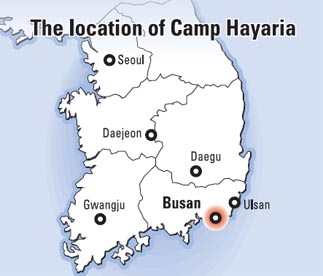U.S. base in Busan will be returned

Busan’s Hayaria base, spread over 528,000 square meters (5.7 million square feet), was closed in August 2006. Korea and the United States have since discussed ways to deal with polluted spots on the base before completing the transfer of possession to Korea.
The contentious issue in the protracted negotiations had been the different environment standards applied to contamination on bases, the Foreign Ministry explained.
Under the principle of Known, Imminent and Substantial Endangerment (KISE) to human health included in the Status of Forces Agreement, the U.S. government doesn’t assume responsibility for the cleanup unless the danger meets KISE standards.
On the other hand, Korea has its own, stricter standards under local environmental laws that focus on the concentration of polluting substances.
The U.S. military had cleansed the majority of the contaminated soil on the base, leaving less than 0.3 percent of the base polluted.
Had the negotiations continued, the United States could have been forced to finish the cleaning, said Lee Baek-soon, deputy director general of the North American affairs bureau at the Foreign Ministry. But the Busan metropolitan government pushed for the fast return of the land so that it could develop a public park there. Lee, the chief Korean negotiator, explained that after weighing different options, Korea concluded it wouldn’t be worth it to keep on negotiating.
Convenience and development for Busan citizens were ultimately deemed more important, a diplomatic source told the JoongAng Daily.
“We felt that it was important to acquire the land quickly for the sake of regional development because the contaminated area was really small and the level of contamination was minor,” the source said. “And it might cost us around 300 million won [$267,600], which isn’t much in the grand scheme of things. You could make that much money quickly by leasing a piece of land on the base.”
The two sides agreed in writing that this Busan case wouldn’t be a precedent, the source said.
“After taking into account various factors, we decided to assume the cleanup costs this time,” he said. “But we established a clear understanding with the United States that it won’t be used as an example for transfers in the future.”
There are 40 U.S. bases to be returned to Korea. The two sides have established a nonbinding framework to facilitate future negotiations over environmental issues, Lee said.
By Yoo Jee-ho [jeeho@joongang.co.kr]
Related Korean Article
굴곡의 근현대사 상징 `美하야리아의 역사`
부산 미 하야리아 부대는 우리나라 굴곡의 근현대사를 상징하는 시설물 중 하나였다.
부산 부산진구 초읍동에 위치한 하야리아 부지는 일제강점기에는 일본인들의 경마장과 마권판매장으로 사용됐고, 2차 대전 당시에는 일본군 훈련장으로 활용됐다.
이어 한국전쟁 발발 직후인 1950년 9월부터는 주한 미군부산기지사령부가 주둔하면서 미군 군수기지로 사용됐으며, 2010년 1월 한미 정부 간 반환협상이 최종 타결될 때까지 100년 넘게 우리 땅이 아니었다.
부산 도심에 위치해 있지만 이국의 땅으로만 여겨졌던 하야리아 부지를 되찾기 위한 움직임은 1993년 부산진구의회가 부지반환을 정부에 건의하면서 고개를 들기 시작해 1995년 부산시민사회단체의 반환운동으로 본격화됐다.
시민들이 부대를 둘러싸는 '인간띠 잇기'를 통해 전 시민적인, 국민적인 관심을 촉발시켰고, 당시 부지반환 서명운동에는 150만명이 참여하기도 했다.
시민들의 반환요구는 1999년 부산 중구 대청동 미문화원 부지와 부산진구 국립국악원 자리에 있던 당시 미군장교숙소인 유솜(USOM)부지 반환이 이뤄지면서 더 거세졌다.
그리고 미군은 2001년 하야리아 부대 부지를 2011년까지 반환하겠다고 공식 발표했고, 2006년 기지 폐쇄에 이어 오염토지 처리비용 부담을 둘러싼 4년여간의 지루한 협상 끝에 2010년 1월 드디어 부산시민의 품으로 돌아왔다.
한글 원문 기사 보기
굴곡의 근현대사 상징 `美하야리아의 역사`
부산 미 하야리아 부대는 우리나라 굴곡의 근현대사를 상징하는 시설물 중 하나였다.
부산 부산진구 초읍동에 위치한 하야리아 부지는 일제강점기에는 일본인들의 경마장과 마권판매장으로 사용됐고, 2차 대전 당시에는 일본군 훈련장으로 활용됐다.
이어 한국전쟁 발발 직후인 1950년 9월부터는 주한 미군부산기지사령부가 주둔하면서 미군 군수기지로 사용됐으며, 2010년 1월 한미 정부 간 반환협상이 최종 타결될 때까지 100년 넘게 우리 땅이 아니었다.
부산 도심에 위치해 있지만 이국의 땅으로만 여겨졌던 하야리아 부지를 되찾기 위한 움직임은 1993년 부산진구의회가 부지반환을 정부에 건의하면서 고개를 들기 시작해 1995년 부산시민사회단체의 반환운동으로 본격화됐다.
시민들이 부대를 둘러싸는 '인간띠 잇기'를 통해 전 시민적인, 국민적인 관심을 촉발시켰고, 당시 부지반환 서명운동에는 150만명이 참여하기도 했다.
시민들의 반환요구는 1999년 부산 중구 대청동 미문화원 부지와 부산진구 국립국악원 자리에 있던 당시 미군장교숙소인 유솜(USOM)부지 반환이 이뤄지면서 더 거세졌다.
그리고 미군은 2001년 하야리아 부대 부지를 2011년까지 반환하겠다고 공식 발표했고, 2006년 기지 폐쇄에 이어 오염토지 처리비용 부담을 둘러싼 4년여간의 지루한 협상 끝에 2010년 1월 드디어 부산시민의 품으로 돌아왔다.










with the Korea JoongAng Daily
To write comments, please log in to one of the accounts.
Standards Board Policy (0/250자)